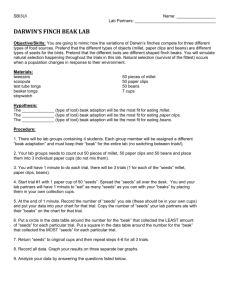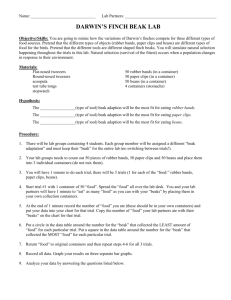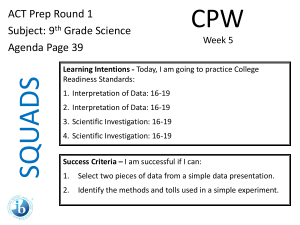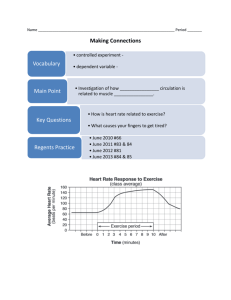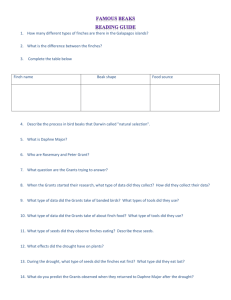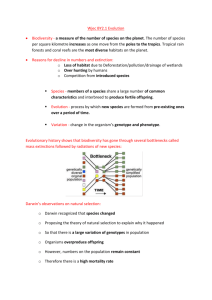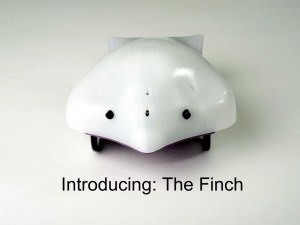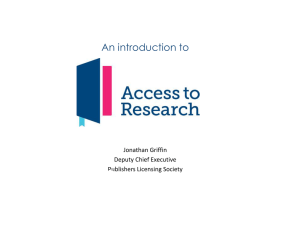DARWIN*S FINCH BEAK LAB
advertisement
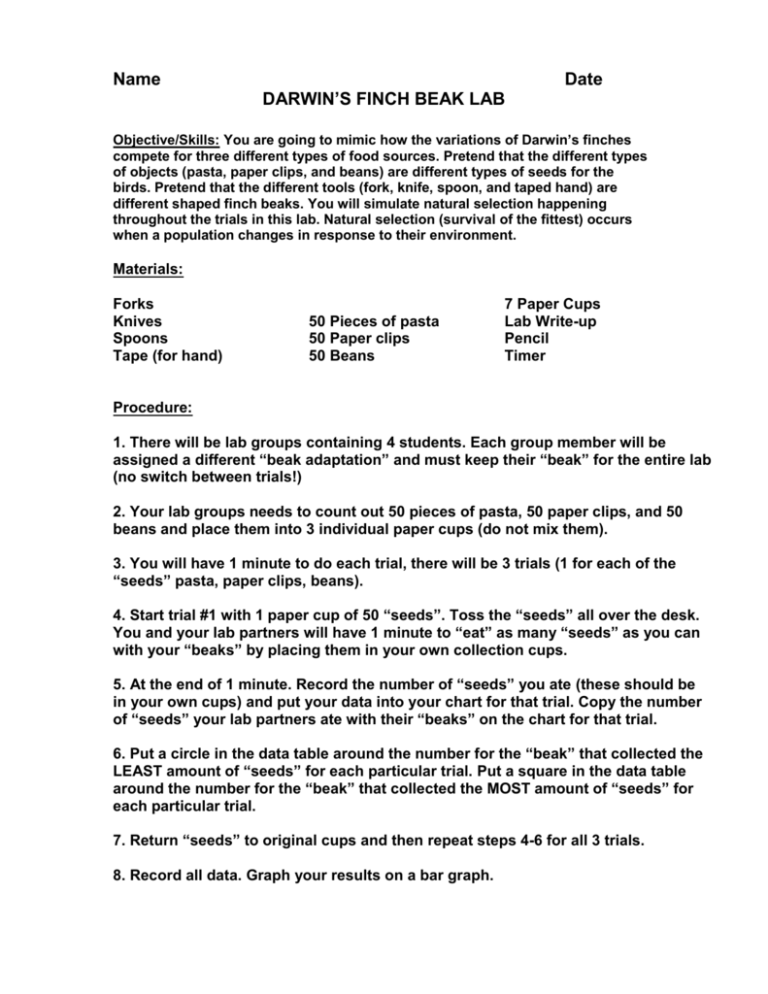
Name Date DARWIN’S FINCH BEAK LAB Objective/Skills: You are going to mimic how the variations of Darwin’s finches compete for three different types of food sources. Pretend that the different types of objects (pasta, paper clips, and beans) are different types of seeds for the birds. Pretend that the different tools (fork, knife, spoon, and taped hand) are different shaped finch beaks. You will simulate natural selection happening throughout the trials in this lab. Natural selection (survival of the fittest) occurs when a population changes in response to their environment. Materials: Forks Knives Spoons Tape (for hand) 50 Pieces of pasta 50 Paper clips 50 Beans 7 Paper Cups Lab Write-up Pencil Timer Procedure: 1. There will be lab groups containing 4 students. Each group member will be assigned a different “beak adaptation” and must keep their “beak” for the entire lab (no switch between trials!) 2. Your lab groups needs to count out 50 pieces of pasta, 50 paper clips, and 50 beans and place them into 3 individual paper cups (do not mix them). 3. You will have 1 minute to do each trial, there will be 3 trials (1 for each of the “seeds” pasta, paper clips, beans). 4. Start trial #1 with 1 paper cup of 50 “seeds”. Toss the “seeds” all over the desk. You and your lab partners will have 1 minute to “eat” as many “seeds” as you can with your “beaks” by placing them in your own collection cups. 5. At the end of 1 minute. Record the number of “seeds” you ate (these should be in your own cups) and put your data into your chart for that trial. Copy the number of “seeds” your lab partners ate with their “beaks” on the chart for that trial. 6. Put a circle in the data table around the number for the “beak” that collected the LEAST amount of “seeds” for each particular trial. Put a square in the data table around the number for the “beak” that collected the MOST amount of “seeds” for each particular trial. 7. Return “seeds” to original cups and then repeat steps 4-6 for all 3 trials. 8. Record all data. Graph your results on a bar graph. 9. Analyze your data by comparing how fit for the environment each “beak” was, compared to the other “beaks” in your lab group. Hypothesis: Choose one of the following: knife, spoon, fork or taped hand. I believe that the ______________ (type of tool) beak adaption will be the most fit for eating pasta. I believe that the ______________ (type of tool) beak adaption will be the most fit for eating paper clips. I believe that the ______________ (type of tool) beak adaption will be the most fit for eating beans. Data: (make these charts on your lab write-up) Circle the LOWEST performing “beak” for each trial (this represents extinction) Put a box around the HIGHEST performing “beak” for each trial Trial #1 Pasta Seed Type # of Pasta eaten Knife Spoon Fork Taped Hand TOTAL Knife Spoon Fork Taped Hand TOTAL Knife Spoon Fork Taped Hand TOTAL Knife Fork Taped Hand TOTAL 10 Spoon 41 Knife Spoon Fork Trial #2 Paper Clips Seed Type # of Paper Clips eaten Trial #3 Beans Seed Type # of Beans eaten EXAMPLE: Trial #1 Pasta Seed Type # of Pasta eaten 24 29 104 Trial #2 Paper Clips Seed Type # of Paper Clips eaten 5 0 TOTAL 14 Taped Hand 40 Fork Taped Hand TOTAL 25 19 75 59 Trial #3 Beans Seed Type # of Beans eaten Knife 5 Spoon 26 Graph: Create three separate bar graph clusters. Trial # (seed type) is on the x-axis and the total number of “seeds” collected in that trial is on the y-axis. Use a legend and colored bars to graph all of the four beak adaptations for each trial cluster. This needs to be done in either Excel or Word. Example: 41 Knife 40 Spoon Fork Taped Hand 29 26 24 25 19 14 10 5 5 0 Analysis: Refer to your charts and bar graphs to answer the following questions 1. Which finch became extinct in trial #1 pasta?________________________________ 2. Why did this finch become extinct?_________________________________________ 3. Which finch was best fit for survival on this “seed” type?________________________ 4. Why was this finch best fit for survival? _____________________________________ 5. Which finch became extinct in trial #2 paper clips?____________________________ 6. Why did this finch become extinct?_________________________________________ 7. Which finch was best fit for survival on this “seed” type?_________________________ 8. Why was this finch best fit for survival? ______________________________________ 9. Which finch became extinct in trial #3 beans?________________________________ 10. Why did this finch become extinct?________________________________________ 11. Which finch was best fit for survival on this “seed” type?________________________ 12. Why was this finch best fit for survival? _____________________________________ By analyzing all of the trials’ collected data: 15. Which finch “beak” performed best over all the trials?_________________________ 16. Why did this finch “beak” perform best? ____________________________________ _______________________________________________________________________ 17. Which finch “beak” performed worst over all the trials?_________________________ 18. Why did this finch “beak” perform worst? ___________________________________ _______________________________________________________________________ 19. What were some hidden factors (did you develop a strategy) you realized while doing these trials to help your “beak” eat more “seeds” during the trial? ___________________ _______________________________________________________________________ 20. How does this relate to animals in real life? _________________________________ _______________________________________________________________________ 21. How might these finches avoid extinction due to competition? ___________________ _______________________________________________________________________ Conclusion: Explain and discuss what you have learned about evolution by natural selection during this lab by using ALL of the following terms in a paragraph: population, environment, competition, fitness, adaptation, and extinction.

